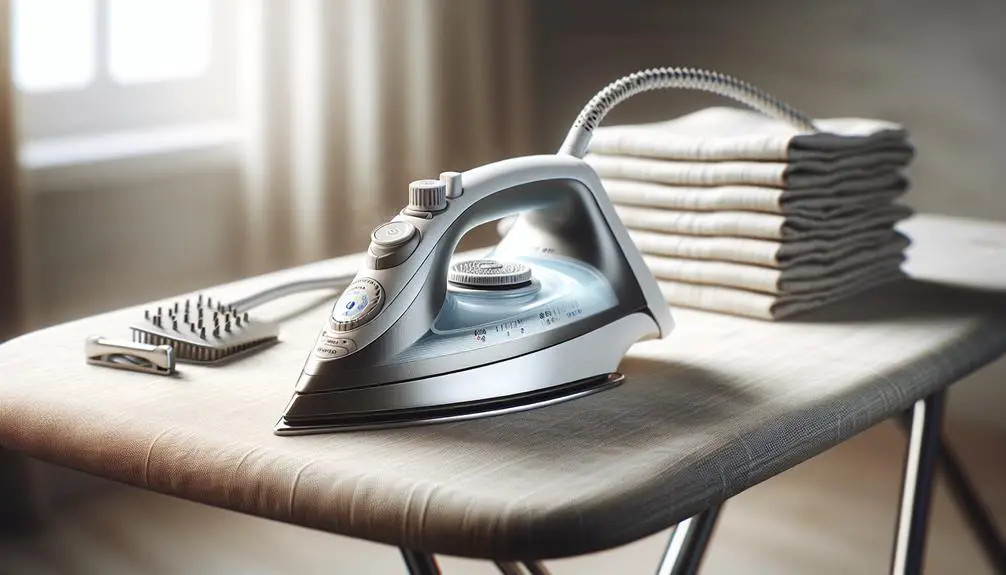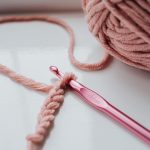When I first tried to press my linen shirt, I set the temperature too high, and it ended up looking like a crumpled paper ball.
Finding the right temperature setting for linen can be like walking a tightrope – too low, and the wrinkles won't budge; too high, and you risk scorching the fabric.
But fear not, there's a secret spot that will have your linen looking crisp and fresh.
Want to know more about discovering the secret to perfect linen ironing?
Table of Contents
Key Takeaways
- Adjust iron to medium-high temperature for effective linen ironing.
- Test iron temperature on a small area first to prevent damage.
- Iron linen when slightly damp for best results.
- Use steam, divide garment into sections, and follow care label instructions for optimal ironing.
Importance of Setting the Right Temperature
Setting the iron to the correct temperature is essential for achieving wrinkle-free and crisp linen garments. Proper heat control is vital in fabric care, especially when dealing with delicate materials like linen. Linen is a natural fiber known for its breathability and luxurious feel, but it can easily be damaged if subjected to high heat. To guarantee the longevity of your linen pieces, it's imperative to adjust the iron temperature according to the garment's care label.
When ironing linen, it's recommended to set the iron to a medium-high temperature. This setting allows for effective wrinkle removal without causing scorch marks or shine on the fabric. By paying attention to heat control, you can maintain the integrity of your linen items and keep them looking pristine for years to come.
Understanding Linen Ironing Temperatures
To guarantee proper care for your linen garments, understanding the appropriate ironing temperatures is key to maintaining their quality and longevity. Linen is a delicate fabric that requires special attention when it comes to ironing. When dealing with linen, it's important to set your iron to a medium-high temperature. Too much heat can scorch the fibers, leading to permanent damage. It's always advisable to test a small, inconspicuous area first before ironing the entire garment.
Proper fabric care involves knowing the ideal temperature settings for different types of fabric. Linen, being prone to wrinkles, benefits from a slightly damp cloth placed over it during ironing. This helps in achieving a smoother finish without subjecting the fabric to excessive heat. Ironing techniques play a significant role in maintaining the pristine look of your linen garments. Remember to move the iron in straight lines to prevent stretching or distorting the fabric. By mastering the art of ironing linen at the right temperature, you can make sure your clothing remains in top condition for years to come.
Tips for Ironing Linen Effectively
For achieving wrinkle-free linen garments, mastering the proper ironing techniques is essential. When it comes to ironing linen effectively, there are some key tips to keep in mind. Here are five tips to help you achieve that crisp, polished look:
- Use a Steam Iron: Steam ironing is highly effective for linen as it helps relax the fibers and smooth out wrinkles with ease.
- Iron While Damp: Linen is best ironed when slightly damp. Avoid waiting until it's completely dry as this can make ironing more challenging.
- Work in Sections: Divide the garment into manageable sections to guarantee each part receives equal attention and a thorough ironing.
- Adjust Temperature Accordingly: Linen can withstand high heat, but it's important to adjust the iron's temperature based on the garment's thickness to prevent scorching.
- Hang Immediately: Once ironed, hang your linen garments on sturdy hangers to maintain their smoothness and prevent new wrinkles from forming.
Common Mistakes to Avoid
When ironing linen garments, one common mistake to avoid is ironing over stubborn wrinkles repeatedly, as this can damage the fabric and make the wrinkles more difficult to remove. Instead, gently stretch the fabric while ironing to help release the wrinkles.
Another frequently made error is using the wrong ironing techniques. It's important to follow the garment care label instructions for the appropriate ironing temperature to prevent scorching or burning the fabric. Always test a small, inconspicuous area first if you're unsure.
Additionally, neglecting fabric care can lead to unwanted outcomes. Linen is a delicate material that requires special attention. Avoid using harsh chemicals or bleach when washing linen, as this can weaken the fibers and make them more prone to damage during ironing.
FAQs About Ironing Linen
Exploring the ironing process for linen garments can raise some common questions that we'll address in this section. When it comes to linen care and ironing techniques, having a good grasp of the basics is crucial. Here are some frequently asked questions about ironing linen:
- How hot should the iron be for linen clothes?
Linen is best ironed when slightly damp on the highest setting suitable for linen fabrics.
- Should I iron linen inside out?
Yes, turning your linen garments inside out before ironing can help prevent any shine or damage to the fabric.
- Can I use steam when ironing linen?
Yes, steam can be beneficial when ironing linen as it helps release wrinkles effectively.
- Is it necessary to use a pressing cloth when ironing linen?
Using a pressing cloth is recommended to protect the fabric from direct heat and prevent shine marks.
- Any specific ironing techniques for delicate linen items?
For delicate linen pieces, consider using a lower heat setting and ironing them inside a clean pillowcase to avoid direct contact with the iron's plate.
Ironing linen can be a straightforward task with the right techniques and care.
Frequently Asked Questions
Can Linen Be Ironed on the Highest Setting of the Iron?
Ironing linen on the highest setting of an iron is not recommended. It's important to follow proper ironing techniques to avoid scorching or damaging the fabric. Opt for a lower temperature setting for better fabric care.
What Happens if the Iron Temperature Is Too Low for Linen?
When ironing, I adjust heat settings for linen to prevent fabric damage. If the iron temperature is too low, wrinkles won't smooth out easily, prolonging ironing time. Proper ironing technique guarantees crisp results without compromising the fabric.
How Can I Prevent My Linen From Getting Shiny or Burnt When Ironing?
To prevent my linen from getting shiny or burnt when ironing, I focus on proper ironing techniques. I iron linen inside out, use a pressing cloth, and avoid excessive heat. These steps help maintain the fabric's integrity and prevent damage.
Is It Necessary to Use Steam When Ironing Linen?
When ironing linen, using steam can be beneficial to remove wrinkles effectively. It helps relax the fabric fibers, making the ironing process smoother. Adjust your ironing techniques to accommodate steam, ensuring a crisp and polished finish.
Can Linen Be Ironed When It Is Damp or Wet?
Yes, linen can be ironed when slightly damp for better results. This technique helps smoothen wrinkles effectively. It's important to follow proper ironing techniques to avoid damaging the fabric. Always prioritize fabric care for best results.
- What Is the “Dye-Over-Ice” Technique? - July 13, 2025
- Comparing Fiber Reactive Dyes vs. All-Purpose Dyes - July 13, 2025
- Tie-Dye With Natural Dyes: an Eco-Friendly Guide - July 13, 2025






